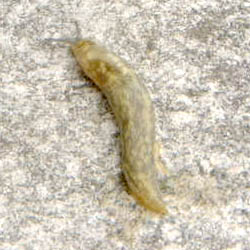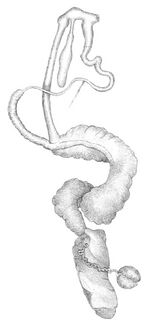Biology:Limax flavus
| Limax flavus | |
|---|---|

| |
| Scientific classification | |
| Kingdom: | |
| Phylum: | |
| Class: | |
| (unranked): | clade Heterobranchia
informal group Pulmonata clade Eupulmonata clade Stylommatophora informal group Sigmurethra clade limacoid clade |
| Superfamily: | |
| Family: | |
| Subfamily: | |
| Genus: | |
| Subgenus: | |
| Species: | L. flavus
|
| Binomial name | |
| Limax flavus | |
| Synonyms | |
|
Limacus flavus | |
Limax flavus (syn. Limacus flavus), known commonly as the cellar slug, the yellow slug, or the tawny garden slug, is a medium to large species of air-breathing land slug, a terrestrial pulmonate gastropod mollusk in the family Limacidae.[1]
Description
This slug has a yellow body with grey mottling, and pale blue tentacles. When extended, the body length can be 7.5 to 10 cm (3.0 to 3.9 in).[2]

Distribution
The yellow slug is common in Scotland, England , Wales and Ireland as well as most of southern and western Europe. It has been accidentally introduced in many other parts of the world.
Behavior
Yellow slugs, like the majority of other land slugs, use two pairs of tentacles on their heads to sense their environment. The upper pair, called optical tentacles, is used to sense light. The lower pair, oral tentacles, provide the slug's sense of smell. Both pairs can retract and extend themselves to avoid hazards, and, if lost to an accident or predation, can be regrown.
Like all slugs, the yellow slug moves relatively slowly, gliding along using a series of muscular contractions on the underside of its foot, which is lubricated with mucus, such that it leaves a slime trail behind it.
Ecology
This species feeds mostly on fungi, decaying matter,[6] and vegetables.
Habitat
This species is strongly associated with human habitation, and is usually found in damp areas such as cellars, kitchens, and gardens or under stones. Generally speaking it is only seen at night, because it is nocturnal. Thus often it goes unnoticed and people are unaware of how (relatively) common the species is.
Parasites
Parasites of Limax flavus include the nematode Angiostoma spiridonovi.[7]
References
- ↑ Marshall, B. (2014). Milax gagates (Draparnaud, 1801). Accessed through: World Register of Marine Species at http://www.marinespecies.org/aphia.php?p=taxdetails&id=819993 on 2014-11-06
- ↑ Tiscali Encyclopaedia . Retrieved March 25, 2005.
- ↑ Kerney M.P. and Cameron R.A.D., 1979, A field guide to the land snails of Britain and north-west Europe. Collins.
- ↑ Balashov I. & Gural-Sverlova N. 2012. An annotated checklist of the terrestrial molluscs of Ukraine. Journal of Conchology. 41 (1): 91-109.
- ↑ Wiktor A., De-niu C. & Wu M. (2000). "Stylommatophoran slugs of China (Gastropoda: Pulmonata) – prodromus". Folia Malacologica 8(1): 3-35.
- ↑ Bennett, S. M. 2000. Yellow Slugs. Retrieved March 25, 2005.
- ↑ Morand, S. (1992) Angiostoma spiridonovi sp. n. (Nematoda: Angiostomatidae) from Limax flavus (Gastropoda: Limacidae). Journal of the Helminthological Society of Washington 59 212–17.
- Spencer, H.G., Marshall, B.A. & Willan, R.C. (2009). Checklist of New Zealand living Mollusca. pp 196–219 in Gordon, D.P. (ed.) New Zealand inventory of biodiversity. Volume one. Kingdom Animalia: Radiata, Lophotrochozoa, Deuterostomia. Canterbury University Press, Christchurch.
External links
| Wikimedia Commons has media related to Limax flavus. |
- Limax flavus at Animalbase taxonomy, short description, distribution, biology, status (threats), images
- Image of the Great Yellow Slug
Wikidata ☰ Q175818 entry

